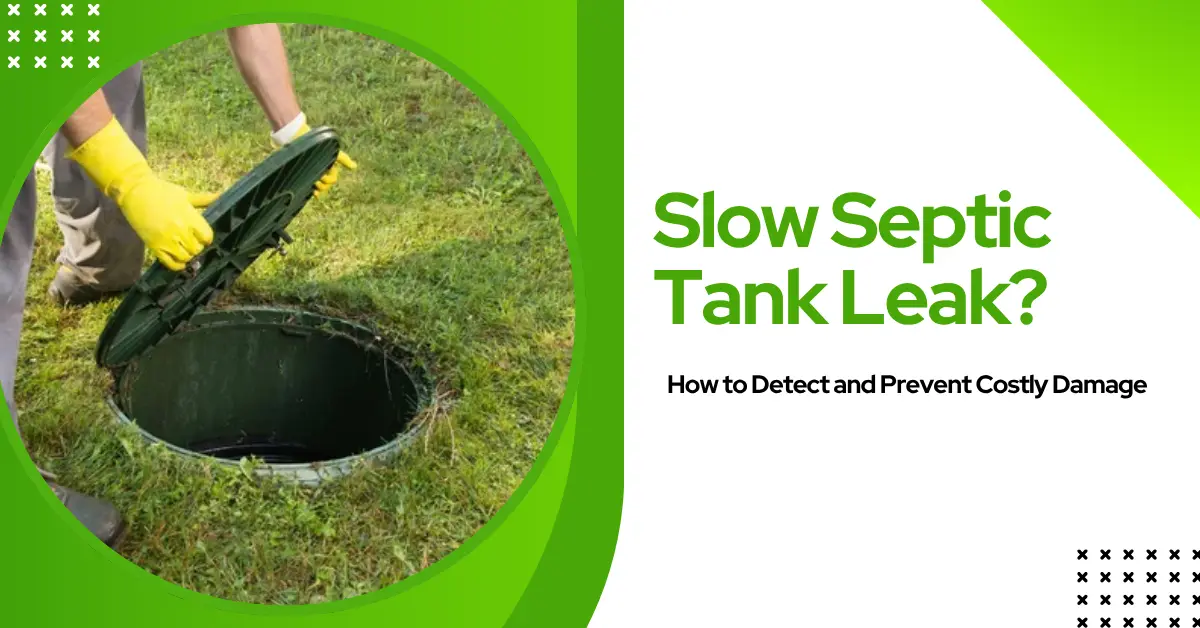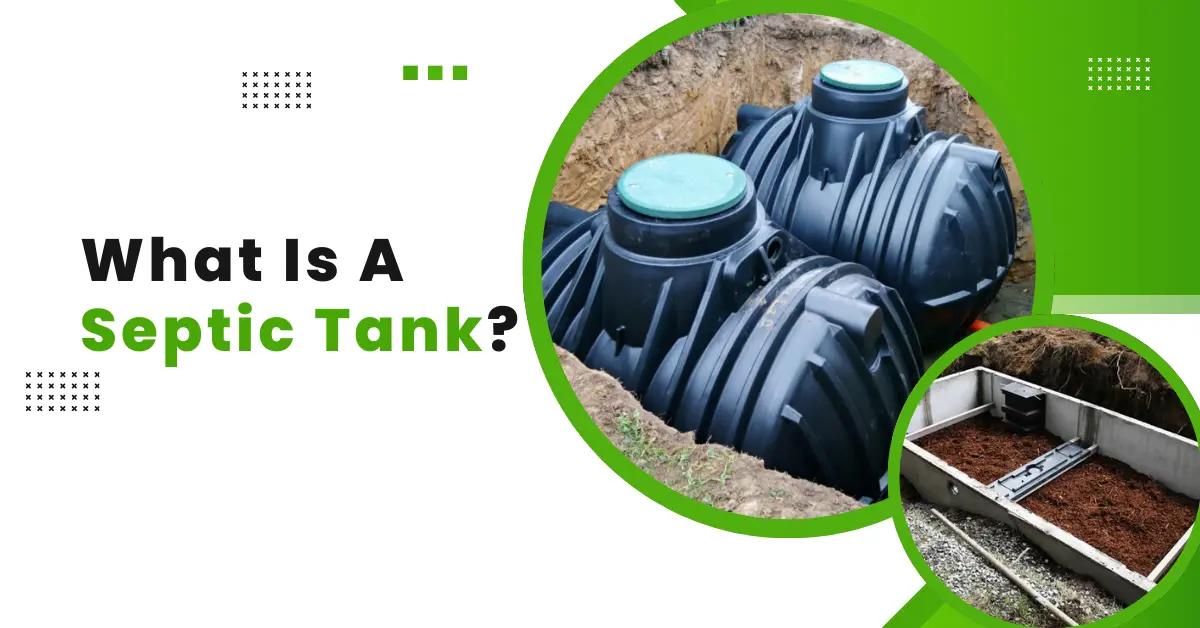Wondering if you have a slow leak into septic tank? It hides beneath the surface, quietly damaging your system until it fails.
It starts with a trickle that can quietly lead to sewage backups, nasty odors, contaminated soil, and even potential health hazards for your family and pets.
Common causes of a slow septic tank leak include broken pipes, groundwater intrusion, or backflow from saturated soil.
This leak puts pressure on the tank, overloads the drain field, and wears down the entire system, some of the earliest signs of septic system failure.
However, you can fix the septic leak by inspecting for broken pipes, sealing cracks, and redirecting surface water.
In this comprehensive guide, you’ll get to know what a slow septic tank leak is, why it happens, the subtle signs to watch for, and what to do next.
Additionally, you’ll learn how your system works, how leaks are diagnosed, and what steps you can take.
Therefore, let’s get started!
Common Causes of a Slow Leak Into a Septic Tank
At first, you need to understand these common causes, which can help you catch problems early and avoid costly repairs.
Below are the main reasons a slow leak may develop in your septic tank system.
1. Root Intrusion
Tree roots naturally seek moisture and nutrients, which is why they target septic tanks and underground pipes.
Roots push through tiny cracks or gaps in pipes, slowly force them apart, and damage the structure.
As they spread, they clog the flow, trigger leaks, and build pressure that eventually disrupts the entire septic line
2. High Water Table or Groundwater Intrusion
In places with high water tables or heavy rain, saturated soil builds pressure around the septic tank and pipes.
This pressure pushes groundwater through cracks or loose seals and causes leaks.
As a result, the tank’s function weakens, and the wastewater becomes diluted, which lowers the overall treatment efficiency.
If the soil can no longer properly absorb wastewater, it may be due to a septic tank percolation problem that affects the entire drain field.
3. Cracks or Structural Damage to the Tank
Septic tanks, whether concrete, fiberglass, or plastic, face wear and tear over time.
Concrete tanks can crack from soil movement, while fiberglass and plastic tanks may break under impact or chemical stress.
When tank walls or the base split, water seeps in or waste leaks out, eventually, it weakens the system and creates serious problems.
4. Improper or Delayed Maintenance
Skipping regular septic tank pumping lets sludge and scum pile up.
This clogs pipes, triggers backflow, and puts extra pressure on the tank. As strain builds, cracks form and leaks start.
It ultimately damages the system from the inside out.
5. Excessive Household Water Use
Using too much water, like running several appliances at once, can burden a septic system built for normal household flow.
This overuse puts stress on the tank and the drain field. After a while, it wears them down faster and raising the chance of a leak.
6. Pipe Joint Failure
The pipes linking your septic tank to your home and drain field rely on tightly sealed joints.
Over time, ground shifts, corrosion, or bad installation can loosen or damage these joints.
When that happens, wastewater escapes into the soil and disrupts the system.
7. Internal Fixture Leaks
Leaky toilets, dripping faucets, or sump pumps discharging into the septic system may appear harmless, but they send a steady stream of excess water.
This nonstop inflow puts strain on the tank and the drain field. At some point, it raises internal pressure and increases the chances of leaks or premature system failure.
Signs and Symptoms of a Slow Leak
Watch out for these common symptoms, they might indicate a slow leak.
1. Gurgling Sounds in Pipes
Gurgling or bubbling noises coming from drains usually mean trapped air is being forced through blockages. This is one of the early symptoms for early septic issues.
2. Slow Drainage in Fixtures
If sinks, toilets, or tubs begin draining more slowly than usual, it’s often a sign of trouble in your septic system.
This happens when the tank is bogged down and can’t handle normal flow.
3. Foul, Sewage‑Like Odors Outdoors
That rotten-egg or sewage scent around your tank, drain field, or yard is usually due to escaping gases or leaking wastewater. You must not ignore this sign.
4. Persistent Soggy Soil or Standing Water Near the Tank
Pooling water or soggy patches around your tank or drain field, even when it hasn’t rained, is a strong sign of wastewater leaking.
5. Low Water Level in the Tank
If your tank looks unusually empty when household fixtures are running, it may signal that water (or effluent) is leaking out.
Not sure how to confirm? Here’s how to tell if your septic tank is leaking, look for a mix of physical, audible, and environmental cues that often point to system trouble.
6. Visible Drips or Water Trickling Into the Tank
Sometimes, you’ll see water entering the tank through cracks or joint failures. It indicates a potential slow leak.
7. Lush, Fast‑Growing Grass Over the Drain Field
Unusually green, thick grass above the drain field can mean nutrients from a septic leak are fertilizing it.
How to Diagnose the Problem?
Follow this step-by-step checklist, from simple home checks to professional diagnostics, to avoid common mistakes.
Home Inspection Checklist
Start your diagnosis with basic checks you can perform easily.
Step 1: Locate All System Components
Begin by identifying where your septic tank lids, inspection ports, and drain field are situated.
When you have a clear idea about their locations makes routine checks and maintenance much easier.
Step 2: Perform a Visual Inspection
Look closely around the tank and the drain field area.
Signs like cracks in the soil, standing water, soggy patches, or unusually green and fast-growing grass can indicate wastewater leakage.
Step 3: Do a Smell Test
Walk around the septic area and take note of any unpleasant odors.
A strong sewage smell or rotten egg scent (caused by hydrogen sulfide gas) is a danger sign that something may be leaking underground.
Step 4: Check System Performance
Pay attention to how your home’s drains are working.
Slow-draining sinks, toilets, or tubs, as well as gurgling noises, may signal a clog or backup somewhere in the system.
Professional Diagnostic Tools & Techniques
If initial signs are concerning, you’d better call professionals. They mostly use these techniques.
Step 1: Camera Scopes
A flexible video scope is inserted into the pipes to visually check for issues like cracks, root intrusion, or failed joints, especially between your house and the septic tank.
This method gives a clear, real-time view of hidden problems inside the system.
Step 2: Conduct a Dye Test
Flush a non-toxic colored dye into a toilet or drain.
If the dye appears outside the tank, in your yard, or near the drainfield, it signals a leak in the system that needs immediate attention.
Step 3: Perform a Pressure Test
This test helps evaluate how well the soil absorption field is working.
If there’s low pressure or uneven water distribution, it may point to clogs, saturation, or hidden leaks.
Step 4: Use Smoke Testing
Non-toxic smoke is pumped through the septic system under light pressure.
If the smoke escapes through any cracks, open joints, or faults, it reveals exactly where leaks or breaks exist, especially effective for underground diagnostics.
Solutions: How to Fix a Slow Leak Into a Septic Tank?
Here’s how to approach the issues.
1. Inspection First!
Start with checking the area around the tank and drain field for soggy soil, standing water, or unusually lush patches of grass.
Listen closely for trickling or running water sounds when no fixtures are in use, as this could point to internal leaks.
Pay attention to foul odors near the tank or drainfield; a persistent sewage smell often signals leakage or backflow.
Check the water level in your septic tank. If it’s unexpectedly low while the house is in use, that could confirm a leak.
For more accurate results, consider using professional tools like camera scopes, smoke testing, septic-safe dye tests, or pressure gauges to pinpoint the exact location of the problem.
2. Pipe and Joint Repair
Leaks or joint failures usually result from shifting soil or aging pipes.
Traditional dig-and-replace works, but trenchless repairs are faster and less disruptive. Always inspect the pipe connecting your house to the tank.
3. Root Removal and Control
Tree roots can break into pipes through tiny joints, drawn by moisture.
Use a mechanical auger to remove them, then apply a foaming root killer like copper sulfate (if locally permitted) to prevent regrowth.
For recurring issues, consider rerouting pipes or installing root barriers for long-term protection.
4. Redirecting Water Sources
Ensure gutter downspouts are properly rerouted, sump pump discharge, and surface runoff are away from the septic tank and drain field.
Too much external water, especially in high water table areas, can lead to groundwater intrusion.
Proper drainage is key to preventing system overload.
5. Water Usage Management
Install low-flow showerheads, toilets, and faucet aerators to cut down water usage.
Spread laundry loads over several days to avoid burdening the system.
Remind household members to conserve water, especially during heavy rains or right after the tank has been pumped, to prevent leaks.
6. Tank Repair or Replacement
Hairline cracks in septic tanks can often be sealed using waterproof sealants or epoxy, offering a quick fix for minor issues.
However, if there’s deeper damage or corrosion, particularly in aging concrete or metal tanks, more extensive solutions like epoxy lining or full tank replacement may be necessary.
While DIY patching might seem convenient, it’s usually a short-term fix. For more permanent options, consult this guide on septic tank leak repair to know when to repair and when to replace.
For long-lasting results and to avoid future system failure, it’s best to consult a licensed septic contractor.
7. Pumping the Tank
If your tank is overloaded or showing signs of backup, emergency pumping might be necessary right away.
To avoid this, stick to a routine pumping schedule every 3 – 5 years. This keeps solids from clogging the drain field and prevents costly overflow leaks.
Do NOT pump water out of the drain field, especially during wet conditions. It can cause collapse or field failure.
8. Avoiding Common Septic Mistakes
Never flush grease, wipes, diapers, feminine hygiene products, or harsh chemicals.
These items don’t decompose properly in septic systems and often cause clogs, disrupt essential bacteria, and trigger leaks or system failures.
9. Fixing Indoor Leaks
Running toilets, dripping faucets, or faulty valves may seem minor, but they continuously push water into your septic system. Eventually, it causes an overload.
Fixing these small plumbing issues helps protect your tank and prevent leaks.
10. Know When to Call a Pro
If you’ve inspected everything and the problem persists, or you suspect structural tank damage or drain field failure, hire a certified septic specialist.
They’ll provide a proper diagnosis, offer repair options, and help bring your system back to life.
Preventing Future Leaks in Your Septic System
Here’s how to keep your system running smoothly and leak-free.
1. Stick to a Regular Pumping Schedule
Over time, solids build up in the tank, and if not removed, they can clog the drain field or force effluent out of weak points.
Pump every 3 – 5 years based on household size and water usage.
Larger households or homes with garbage disposals may need more frequent pumping.
2. Schedule Biannual Inspections
Inspections catch small issues before they become major problems. Check tank levels, scum/sludge depth, and signs of tank or drain field stress.
A professional can also inspect baffles, seals, and filters, which are often overlooked.
3. Install Root Barrier Systems
Tree and shrub roots naturally seek moisture, and a septic tank or drain pipe is an easy target.
Use physical root barriers when planting trees near the system.
Avoid planting deep-rooted species like willow, poplar, or maple near the tank or drain field.
Consider chemical root control (copper sulfate) as a maintenance measure.
4. Manage Moisture in Your Landscaping
Too much water near the tank or drain field weakens soil structure and invites intrusion. Redirect runoff from downspouts and roofs away from your septic system.
Don’t install irrigation systems or build patios, driveways, or pools near the drain field.
Keep the area uncompacted and well-drained to allow proper percolation.
5. Install Water-Saving Appliances
Conserving water reduces strain on your system and allows it to process waste more effectively.
Use high-efficiency toilets, low-flow showerheads, and Energy Star washers.
Fix leaks immediately to prevent thousands of gallons from entering the tank needlessly.
6. Educate the Entire Household
Do NOT flush grease, wipes, diapers, feminine hygiene products, or harsh chemicals.
Many septic failures result from simple mistakes.
Avoid overusing bleach or antibacterial cleaners, which disrupt helpful septic bacteria.
FAQs
1. How can I tell if my septic tank is leaking?
Look for soggy patches, foul smells, unusually lush grass over the drain field, slow drainage in fixtures, gurgling sounds, or unusually low water levels in the tank. These are classic signs of septic system failure commonly reported by the EPA and industry experts.
2. What should I do first if I suspect a leak?
Begin with a thorough inspection, check tank levels, smell the drain field area, test drainage, and inspect for standing water. Then reduce household water use to minimize stress on the system while awaiting professional assessment.
3. Can a septic tank leak be repaired, or does it need replacement?
Minor cracks and joint leaks can often be repaired using epoxy sealants or pipe resealing. However, severely damaged or corroded tanks usually require full replacement to ensure long-lasting protection.
4. How often should I pump and inspect to prevent leaks?
According to the EPA, inspect your tank every 1 – 3 years and pump every 3 – 5 years, based on household size and tank usage. Records of maintenance can boost system longevity and resale value.
5. Could groundwater intrusion cause a leak?
Yes. A high water table or excessive surface runoff can saturate nearby soils and push groundwater into tank seams and joints, leading to leakages.
6. Can I use additives to fix or prevent leaks?
No. The EPA cautions that additives aren’t necessary and can even harm the drain field’s function. Stick to regular pumping, inspections, and good usage habits
Wrap Up
A slow leak into your septic tank might seem minor at first, but if it’s left unchecked, it can result in catastrophic drain field failure, groundwater contamination, expensive repairs, and potential code violations.
By investing in regular inspections, timely maintenance, and mindful water usage, you can extend the life of your entire septic system.
Early action prevents thousands in future costs and protects your septic tank.
Flush smart, live clean!






